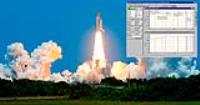 Add My Company
Add My Company
Sign In

Satellite and Launch Vehicle Vibration Qualification Testing
Thursday, March 27, 2014. 10am (Pacific Time, USA).
Thomas Reilly, Director of Product Management, SignalCalc and SignalStar products, will present.
Launch vehicles and satellites are subject to extremely high vibration levels at launch. Failure of critical components can be very costly. For this reason, these systems are subjected to extensive product qualification tests to ensure survivability during launch, deployment and long term operation.
Swept sine testing is a critical component of satellite qualification. Since tests are run on actual flight hardware, prevention of over testing is of critical importance, as is the ability to apply limit channels to an unlimited channel count. Limit channels are used to assign maximum allowable vibration levels at specific locations of the test article. If these levels are reached, the drive signals are limited to reduce the test level. Force limiting can also be used to prevent over testing. In force limiting, load cells are used at the interface between the shaker table and the satellite. Analytical models are typically used to derive the force limit profiles and these profiles are assigned to the load cell channels.
Since actual flight hardware is used in testing, it is essential that all vibration that a satellite is subject to is recorded. This verifies that design limits are not exceeded. For large satellites this can require hundreds of channels of data. Data is typically monitored during the test and raw time history data is recorded for post test analysis. When more channels are required than available in the vibration control system, a dynamic signal analyzer can be used to analyze and record test data.
This seminar will cover the following topics:
Swept sine testing of satellites and launch vehicles
Acceleration and force limiting
Simultaneous recording and analysis of swept sine data using vibration controllers and signal analyzers
Thomas Reilly received a B.S. in Mechanical Engineering from Virginia Tech in 1983. He has 30 years of experience in vibration and acoustic testing and analysis, including more than 20 years of experience working for manufacturers of data acquisition, signal analysis, and vibration control systems.
For more information on Web Seminar: Satellite Vibration Qualification Testing talk to Data Physics (UK) Ltd
Enquire Now
List your company on FindTheNeedle.
